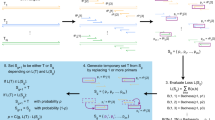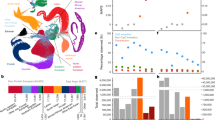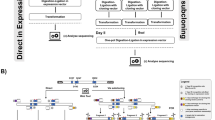Abstract
We describe a novel approach to design a set of primers selective for large groups of genes. This method is based on the distribution frequency of all nucleotide combinations (octa- to decanucleotides), and the combined ability of primer pairs, based on these oligonucleotides, to detect genes. By analyzing 1000 human mRNAs, we found that a surprisingly small subset of octanucleotides is shared by a high proportion of human protein-coding region sense strands. By computer simulation of polymerase chain reactions, a set based on only 30 primers was able to detect approximately 75% of known (and presumably unknown) human protein-coding regions. To validate the method and provide experimental support for the feasibility of the more ambitious goal of targeting human protein-coding regions, we sought to apply the technique to a large protein family: G-protein coupled receptors (GPCRs). Our results indicate that there is sufficient low level homology among human coding regions to allow design of a limited set of primer pairs that can selectively target coding regions in general, as well as genomic subsets (e.g., GPCRs). The approach should be generally applicable to human coding regions, and thus provide an efficient method for analyzing much of the transcriptionally active human genome.
This is a preview of subscription content, access via your institution
Access options
Subscribe to this journal
Receive 12 print issues and online access
$209.00 per year
only $17.42 per issue
Buy this article
- Purchase on Springer Link
- Instant access to full article PDF
Prices may be subject to local taxes which are calculated during checkout
Similar content being viewed by others
References
Lisitsyn, N., Lisitsyn, N., and Wigler, M. 1993. Cloning the differences between two complex genomes. Science 259: 946–951.
Lander, E.S. 1993. Finding similarities and differences between genomes. Nature Genetics 4: 5–6.
Lisitsyn, N.A., Segre, J.A., Kusumi, K., Lisitsyn, N.M., Nadeau, J.H., Frankel, W.N., Wigler, M.H., and Lander, E.S. 1994. Direct isolation of polymorphic markers linked to a trait by genetically directed representational difference analysis. Nature Genetics 6: 57–63.
Zhang, M.Q. and Marr, T.G. 1993. Genome mapping by nonrandom anchoring: a discrete theoretical analysis. Proc. Natl. Acad. Sci. USA 90: 600–604.
Smith, M.W., Holmsen, A.L., Wei, Y.H., Peterson, M., and Evans, G.A. 1994. Genomic sequence sampling: a strategy for high resolution sequence-based physical mapping of complex genomes. Nature Genetics 7: 40–47.
Lee, S.W., Tomasetto, C., and Sager, R. 1991. Positive selection of candidate tumor-suppressor genes by subtractive hybridization. Proc. Natl. Acad. Sci. USA 88: 2825.
Liang, P. and Pardee, A.B. 1992. Differential display of eukaryotic messenger RNA by means of the polymerase chain reaction. Science 257: 967–971.
Liang, P., Averboukh, L., and Pardee, A.B. 1993. Distribution and cloning of eukaryotic mRNAs by means of differential display: refinements and optimizations. Nucleic Acids Res. 21: 3169–3175.
Welsh, J., Chada, K., Dalal, S., Cheng, R., Ralph, D., and McClelland, M. 1992. Arbitrarily primed PCR fingerprinting of RNA. Nucleic Acids Res. 20: 4965–4970.
Libert, F., Parmentier, M., Lefort, A., Dinsart, C., Van Sande, J., Maenhaut, C., Simons, M.-J., Dumont, J.E., and Vassart, G. 1989. Selective amplification and cloning of four new members of the G-protein-coupled receptor family. Science 244: 569–572.
Stone, B. and Wharton, W. 1994. Targeted RNA fingerprinting: the cloning of differentially-expressed cDNA fragments enriched for members of the zinc finger gene family. Nucleic Acids Res. 22: 2612–2618.
Caetano-Anolles, G. 1993. Amplifying DNA with arbitrary oligonucleotide primers. PCR Methods and Applications 3: 85–94.
Caetano-Anolles, G., Bassam, B.J., and Gresshoff, P.M. 1992. Primer-template interactions during DNA amplification fingerprinting with single arbitrary oligonucleotides. Mol. and Gen. Genet. 325: 157–165.
Caetano-Anolles, G., Bassam, B.J., and Gresshoff, P.M. 1991. DNA amplification fingerprinting using very short arbitrary oligonucleotide primers. Bio/Technology 9: 553–557.
Sommer, R. and Tautz, D. 1989. Minimal homology requirements for PCR primers. Nucleic Acids Res. 17: 6749.
Kwok, S., Kellogg, D.E., McKinney, E., Spasic, D., Goda, L., Levenson, C., and Sninsky, J.J. 1990. Effects of primer-template mismatches on the polymerase chain reaction: human immunodeficiency virus type 1 model studies. Nucleic Acids Res. 18: 999–1005.
Gish, W. and States, D.J. 1993. Identification of protein coding regions by database similarity search. Nature Genetics 3: 266–272.
Altschul, S.F., Gish, W., Miller, W., Myers, E.W., and Lipman, D.J. 1990. Basic local alignment search tool. J. Mol. Biol. 215: 03–10.
National Center for Biotechnology Information. 1993. Entrez: Sequences, Releases 6.0 and 7.0. National Institutes of Health, Bethesda, MD.
Dumas, J.P. and Ninio, J. 1982. Efficient algorithms for folding and comparing nucleic acid sequences. Nucleic Acids Res. 10: 197–206.
Claverie, J.M., Sauvaget, I., and Bougueleret, L. 1990. K-tuple frequency analysis: from intron/exon discrimination to T-cell epitope mapping. Methods in Enzymology 183: 237–254.
Griffais, R., Andre, P.M., and Thibon, M. 1991. K-tuple frequency in the human genome and polymerase chain reaction. Nucleic Acids Res. 19: 3887–3891.
Chirgwin, J., Przybyla, A., MacDonald, R., and Rutter, W.J. 1979. Isolation of biologically active ribonucleic acid from sources enriched in ribonuclease. Biochemistry 18: 5294–5299.
Author information
Authors and Affiliations
Rights and permissions
About this article
Cite this article
López-Nieto, C., Nigam, S. Selective amplification of protein-coding regions of large sets of genes using statistically designed primer sets. Nat Biotechnol 14, 857–861 (1996). https://doi.org/10.1038/nbt0796-857
Received:
Accepted:
Issue Date:
DOI: https://doi.org/10.1038/nbt0796-857
This article is cited by
-
Conformational Changes of the Multispecific Transporter Organic Anion Transporter 1 (OAT1/SLC22A6) Suggests a Molecular Mechanism for Initial Stages of Drug and Metabolite Transport
Cell Biochemistry and Biophysics (2011)
-
Multiplex PCR and quality control of Epinotia aporema granulovirus production
Virus Genes (2008)
-
Scanning of nucleic acids by in vitro amplification: New developments and applications
Nature Biotechnology (1996)
-
Abundance and competition in PCR
Nature Biotechnology (1996)
-
Abundance and competition in PCR
Nature Biotechnology (1996)



